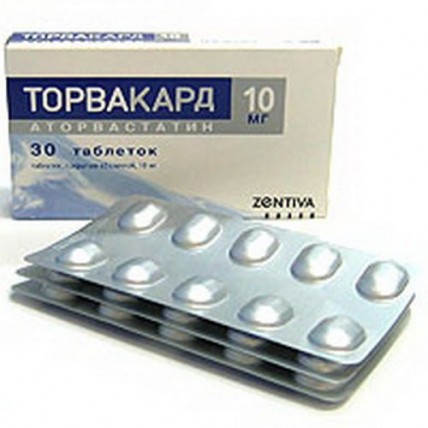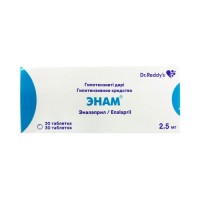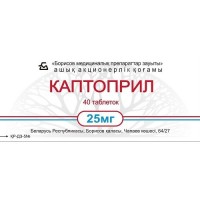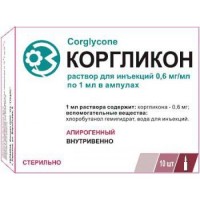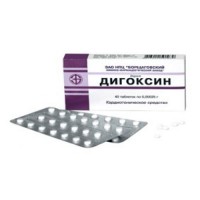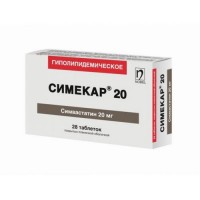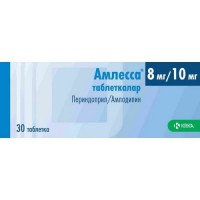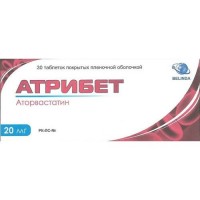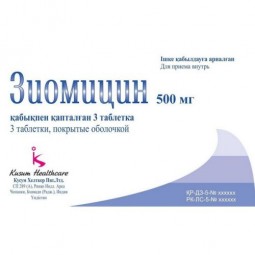Torvakard 30s 10 mg coated tablets
- $22.50
Instruction for medical use
of TORVAKARD medicine
Trade name
of TORVAKARD
International unlicensed
name Atorvastatin Lekarstvennaya
Tablet form, coated 10 mg, 20 mg, 40 mg.
Structure
One tablet contains
active agent – atorvastatin 10.00 mg, 20.00 mg, 40.00 mg (in the form of an atorvastatin of calcium of 10.34 mg, 20.68 mg, 41.36 mg)
excipients: magnesium oxide (heavy), cellulose microcrystalline, lactoses monohydrate, sodium of a kroskarmeloz, hydroxypropyl cellulose the low-substituted LH 21, silicon colloidal anhydrous, magnesium stearate
structure of a cover: gipromelloza 2910/5, macrogoal 6000, titan E171 dioxide, talc.
The description
of the Tablet, coated white or almost white color, an oval form, with a biconvex surface, about 9.0 x 4.5 mm in size (for a dosage of 10 mg).
Tablets, coated white or almost white color, an oval form, with a biconvex surface, about 12.0 x 6.0 mm in size (for a dosage of 20 mg).
Tablets, coated white or almost white color, an oval form, with a biconvex surface, about 13.9 x 6.9 mm in size (for a dosage of 40 mg).
Pharmacotherapeutic group
Hypolipidemic means. GMK-KoA-reduktazy inhibitors
the Code of automatic telephone exchange C10AA05
the Pharmacological
Pharmacokinetics Later properties of intake Torvakard is quickly absorbed, the maximum concentration in plasma (Cmax) is reached in 1–2 hours. Extent of absorption increases in proportion to the accepted dose. After intake, Torvakard, tablets coated, for 95% - 99% of a biodostupna in comparison with oral solution. Absolute bioavailability of Torvakard - low (about 12%), and system availability of the inhibiting activity concerning GMG-KoA-reduktazy – about 30%. The low system bioavailability is caused by presistemny metabolism in a mucous membrane of a GIT and at the first passing through a liver.
The average volume of distribution of Torvakard is about 381 liters. Torvakard's communication with proteins of plasma makes ≥ 98%.
Torvakard is metabolized by P450 3A4 cytochrome to orto- and parahydroxylated derivatives and various products of beta oxidation. In vitro orto- and parahydroxylated metabolites have inhibiting effect on GMG-KoA-reduktazu, comparable to that of Torvakard. About 70% of the circulating inhibiting activity concerning GMG-KoA-reduktazy are defined by active metabolites.
Torvakard is generally brought with bile after hepatic and/or extrahepatic metabolism. However, drug is not exposed to the significant enterohepatic recirculation. Average elimination half-life of Torvakard at the person makes about 14 hours of plasma. Elimination half-life of the inhibiting activity concerning GMG-KoA - reductases makes about 20-30 hours owing to action of active metabolites.
Pharmacokinetics in special cases
− Patients of advanced age: Is higher than Torvakard's concentration and his active metabolites in plasma at healthy patients of advanced age, than at young patients while lipidic effects were comparable to that, observed at population of patients of young age.
− Paul: Torvakard's concentration and his active metabolites at women differ from those at men (Women: Cmax is about 20% higher also than AUC about 10% lower). These distinctions do not represent the clinical importance, without resulting in clinically significant differences in lipidic effects among men and women.
Diseases of kidneys do not influence Torvakard's concentration and his active metabolites in plasma.
Torvakard's concentration and his active metabolites in plasma considerably raise (Cmax: approximately by 16 times and AUC: approximately by 11 times) at patients with the chronic disease of a liver caused by alcohol (class B on a scale of Chayld-Pyyu).
The pharmacodynamics
Torvakard is a selection competitive inhibitor of GMG-KoA-reduktazy, the enzyme limiting speed, 3-hydroxy-3-methyl-glyutaril-coenzyme A, responsible for transformation, in mevalonat, the predecessor of sterols, including cholesterol. In a liver triglycerides and cholesterol are included lipoproteins of very low density (LPONP), come to blood plasma and are transported to peripheral fabrics. Lipoproteins of the low density (LDL) which catabolize mainly by means of interaction with high-affine receptors of LDL are formed of LPONP. Torvakard reduces levels of cholesterol and lipoproteins in blood plasma at the expense of inhibition of GMG-KoA-reduktazy and synthesis of cholesterol in a liver and also due to increase in number of 'hepatic' receptors of the LDL at surfaces of cells increasing capture and a katabolization of LDL. Torvakard reduces production of LDL and quantity of particles of LDL. Torvakard causes the significant and permanent increase in activity of receptors of LDL in combination with favorable changes of quality of the circulating LDL particles. Torvakard effectively reduces level X-LDL at patients with the homozygous hereditary hypercholesterolemia resistant to therapy with other hypolipidemic means.
Torvakard reduces concentration of the general cholesterol by 30-46%, LDL cholesterol for 41-61%, apolipoprotein B for 34-50% and triglycerides for 14-33%, at the same time causing, to a degree, increase of levels of LPVP cholesterol and A1 apolipoprotein, in patients with a heterozygous family hypercholesterolemia, single forms of the hypercholesterolemia mixed by a lipidemia and also in patients with non-insulin-dependent diabetes mellitus. Decrease in level of the general cholesterol, LDL cholesterol and apolipoprotein B reduces risk of cardiovascular diseases and risk of a lethal outcome.
Indications
- as addition to a diet for decrease in the increased content of the general cholesterol, LDL cholesterol, apolipoprotein B, and triglycerides at patients with primary hypercholesterolemia, including a family hypercholesterolemia (heterozygous form) or with the combined (mixed) lipidemia (corresponding to the IIa and IIb types on Fredrikson's classification) when a diet and other not pharmacological methods of treatment are insufficiently effective
- for decrease in content of the general cholesterol and LDL cholesterol at patients with a homozygous family hypercholesterolemia as addition to other types of hypolipidemic therapy (for example, aferez LDL) or if such types of treatment are inaccessible.
- prevention of cardiovascular diseases at the patients who potentially have high risk of the first cardiovascular event as additional therapy.
A route of administration and doses
Before drug Torvakard use the patient should appoint a standard hypolipidemic diet which he has to continue to observe during the entire period of therapy by Torvakard.
During the entire period of treatment the patients have to be under control of the doctor.
The dose of drug is selected individually taking into account the H-LPNP initial levels, by the purposes of therapy and response of an organism.
The standard initial dose makes 10 mg once a day. Correction of a dose has to be carried out with intervals of 4 weeks or more. The maximum dose makes 80 mg once a day.
The daily dose of Torvakard is accepted once at any time with food or irrespective of meal time.
Primary hypercholesterolemia and the combined (mixed) lipidemia
Torvakard of 10 mg once a day. Response to therapy is observed within 2 weeks, and the maximum therapeutic effect is usually reached within 4 weeks. At long therapy this effect remains.
A heterozygous family hypercholesterolemia
Patients should begin treatment with Torvakard's dose of 10 mg a day. When choosing a dose it is necessary to apply individual approach, and it is necessary to adjust these doses each 4 weeks to 40 mg a day. Then, or this dose can be increased to a maximum - 80 mg a day, or it is possible to combine with the drugs strengthening excretion of bile from 40 mg of Torvakard once a day.
The homozygous family hypercholesterolemia
Torvakard's Dose at patients with a homozygous family hypercholesterolemia makes from 10 to 80 mg a day. Torvakard it is necessary to apply at these patients as addition to other types of hypolipidemic therapy (for example, aferez LDL) or if these types of therapy are inaccessible.
Prevention warmly – vascular diseases
At primary prevention a dose makes 10 mg/days. Perhaps, for achievement of levels of cholesterol (LDL) according to the recommendations of the doctor, it is necessary to increase a dose.
Side effects
- a constipation, a meteorism, dyspepsia, nausea, diarrhea, pain in epigastric area
- skin rash, an itching
- an asthenia, insomnia
- a headache, dizziness, paresthesias, hypesthesias
- myalgia, an arthralgia
- a stethalgia, a dorsodynia, peripheral hypostasis
seldom
- anorexia, vomiting
- thrombocytopenia
- a hyperglycemia, a hypoglycemia, pancreatitis,
- an alopecia
- amnesia
- a peripheral neuropathy
- hepatitis, cholestatic jaundice
- urticaria
- sonitus
- a myopathy
- a miositis, a rhabdomyolysis
- impotence
- the indisposition, increase in body weight
is very rare
- an anaphylaxis
- fervescence
- a Quincke's disease
- bullous rash (including a mnogoformny erythema, Stephens-Johnson's syndrome and a toxic epidermal necrolysis)
- increase in level of serumal transaminases (AlT, NUCLEAR HEATING PLANT)
Contraindications
- hypersensitivity to active agent or any excipient of drug
- an active form of a disease of a liver or inexplicable continuous increase in level of transaminases in serum, by 3 times exceeding the upper bound of norm
- a myopathy
- pregnancy and the period of a lactation
- the women of childbearing age who are not taking an appropriate birth control.
Medicinal interactions
Risk of development of a myopathy during treatment by inhibitors of GMG-KoA-reduktazy increases at joint reception with cyclosporine, derivatives of fibroyevy acid, macroleads, including with erythromycin, antifungal drugs of group of azoles, or
Niacinum, in rare instances it leads to a rhabdomyolysis with a renal failure against the background of a myoglobinuria. Therefore, it is necessary to calculate carefully advantage and risk of a concomitant use of drugs.
Torvakard is metabolized by P450 3A4 cytochrome. Medicinal interaction is possible when Torvakard is applied with inhibitors of P450 3A4 cytochrome (for example, with cyclosporine, macroleads, including with erythromycin and klaritromitsiny, nefazodony, antifungal drugs of group of azoles, including with itrakonazoly and HIV protease inhibitors). Joint administration of drugs can lead to Torvakard's increase in blood plasma. Therefore, it is necessary to take special measures when Torvakard is used in a combination with these medicines.
Torvakard and Torvakard's metabolites are R-glycoprotein substrates. R-glycoprotein inhibitors (for example, cyclosporine) can increase Torvakard's bioavailability.
Joint reception of Torvakard of 10 mg once a day and erythromycin (500 mg four times a day), or Torvakarda of 10 mg once a day and a klaritromitsina (500 mg two times a day), the known inhibitors of P450 3A4 cytochrome, was connected with increase in concentration of Torvakard in plasma.
Simultaneous use of Torvakard of 40 mg and an itrakonazol of 200 mg a day leads to triple increase in the area under Torvakard's curve.
Joint reception of Torvakard and inhibitors of protease, is connected with increase in concentration of Torvakard in plasma.
Influence of inductors of P450 3A4 cytochrome (for example, rifampicin or Phenytoinum) on Torvakard is unknown.
The risk of the myopathy caused by Torvakard can increase at joint reception of Torvakard with derivatives of fibroyevy acid. According to results of the researches in vitro, the metabolic way of Torvakard by a glyukuronidation is inhibited gemfibrozily that can lead to increase in concentration of Torvakard in plasma.
Combined use of repeated doses of digoxin and 10 mg of Torvakard does not influence equilibrium concentration of digoxin in plasma. However concentration of digoxin increase approximately by 20% after reception from 80 mg of Torvakard a day. This interaction can be explained with inhibition of membrane transport protein, glycoprotein P-. It is necessary to control the patients accepting digoxin properly.
Combined use of Torvakard with oral contraceptives leads to increase in concentration of norethindrone and ethinylestradiol. These increased concentration should be considered when choosing doses of oral contraceptives.
At a concomitant use of a kolestipol with Torvakard is lower than Torvakard's concentration and his active metabolites in plasma (approximately for 25%). However lipidic effects were higher when the drugs were taken in common than when they were accepted separately.
Combined use of Torvakard and the antiacid suspension containing hydroxides of magnesium and aluminum reduces Torvakard's concentration and his active metabolites in plasma approximately by 35%, however, decrease in level X-LDL does not change.
Combined use of Torvakard and warfarin causes insignificant reduction of a prothrombin time during the first days of reception of doses which returns to norm within 15 days of treatment by Torvakard. Nevertheless, it is necessary to watch closely the patients accepting warfarin when Torvakard is added to therapy.
Joint reception of mnogodnokratny doses of Torvakard and phenazone showed insignificant effect in clearance of phenazone.
The research of interaction of Cimetidinum with Torvakard was conducted, any interaction it was not revealed.
Torvakard's pharmacokinetics in a steady state did not change at combined use of Torvakard of 80 mg and an amlodipina of 10 mg.
Others:
In clinical trials when Torvakard was accepted with antihypertensive or hypoglycemic means of any clinically significant interactions it was not revealed.
Special instructions
Functional hepatic tests should be carried out prior to therapy, and subsequently periodically. Patients who have any symptoms of damage of a liver should carry out functional hepatic tests. Patients at whom the level of transaminases increases should be controlled until disturbance(s) is not allowed. If increase in level of transaminases of norm 3 times higher than the upper bound proceeds, recommended to lower a dose or to cancel Torvakard.
Torvakard it is necessary to apply with care at the patients who are consuming excessive amount of alcoholic beverages and/or having liver diseases in the anamnesis.
Torvakard, just as, and other GMG-KoA inhibitors - reductases, can influence in rare instances skeletal muscles and cause myalgia, a miositis, and a myopathy which can progress to a rhabdomyolysis diseases, potentially life-threatening, characterized by obviously increased kreatinfosfokinaza level (is 10 times higher than the upper bound of norm), a myoglobinemia and a myoglobinuria that can lead to development of a renal failure.
Torvakard patients should appoint with care with the contributing factors of development of a rhabdomyolysis. Level of a kreatinfosfokinaza (KFK) prior to statinovy therapy should be measured in the following situations:
- a renal failure
- a hypothyroidism
- hereditary muscular disorders in the personal or family anamnesis
- a case of the muscular toxicity caused by statine or fibraty in the anamnesis
- a liver disease in the anamnesis and/or consumption of alcoholic beverages in a significant amount
At patients of advanced age (age> of 70 years), it is necessary to consider need of this measurement taking into account existence of other contributing factors of development of a rhabdomyolysis.
In such situations, the risk of treatment should be considered rather possible advantage, and it is recommended to carry out clinical monitoring. Therapy should not be begun if the KFK levels are much higher (5 times higher than the upper bound of norm) norms.
It is not necessary to measure the level of a kreatinfosfokinaza (KFK) after intensive physical activity or in the presence of the probable alternative cause of increase in KFK as it complicates interpretation of values. If the KFK levels considerably exceed initial level (5 times higher than the upper bound of norm), for confirmation of result it is necessary to repeat researches 5 – 7 days later.
During treatment
It is necessary to warn patients, about need to report immediately, about developing of muscular pain, spasms or weakness, especially, if they are followed by an indisposition or fever.
If these symptoms arose during treatment by Torvakard, then it is necessary to measure the KFK levels. If the revealed levels considerably are increased, treatment needs to be stopped.
If muscular symptoms heavy also cause daily discomfort if the KFK levels in 5 and more times exceed the upper bound of norm, it is necessary to consider a question of treatment interruption.
If symptoms passing, and the KFK levels return to norm, it is necessary to consider a question of repeated use of Torvakard or use of alternative statine at low doses and careful monitoring.
Therapy by Torvakard should be cancelled:
- if there was clinically significant increase in the KFK level (> 10 x VGN)
- the diagnosis – a rhabdomyolysis is established, or there are suspicions on its existence.
Risk of developing a rhabdomyolysis increases in case of Torvakard's reception together with drugs: cyclosporine, erythromycin, klaritromitsin, itrakonazol, ketokonazol, nefazodon, Niacinum, gemfibrozit, other derivatives of fibroyevy acid or HIV-inhibitors of protease.
Drug contains lactose monohydrate. Patients with rare inherited disorders of shipping of a galactose,
a lactose intolerance of Lapp, glyukozo-galaktozny malabsorption should not take this drug.
Grapefruit juice contains one or more than one components which inhibits CYP3A4 that can increase plasma concentration of the medicines metaboliziruyemy by means of CYP3A4. Therefore simultaneous use of a large number of grapefruit juice and Torvakard it is not recommended.
A dosage at patients with a renal failure
of the Disease of kidneys have no impact on Torvakard's concentration in plasma and on lipidic effects of Torvakard, therefore, correction of a dose is not required.
Use for patients of advanced age
Efficiency and safety of drug at patients is more senior than 70 years at use of the recommended doses, same, as well as at patients of young age.
Use during pregnancy and breastfeeding
Torvakard is contraindicated at pregnancy and breastfeeding. Women of childbearing age have to take an appropriate birth control. Torvakard's safety at pregnancy and a lactation is not proved.
Use for children and teenagers
These safety of use for children were not estimated.
Features of influence of medicine on ability to run the vehicle or potentially dangerous
Torvakard mechanisms has negative effect on ability of driving by the car and works with mechanisms.
Overdose
Symptoms: Strengthening of side effects is possible.
Treatment: Specific treatment at Torvakard's overdose is not available. If there was Torvakard's overdose, treatment of the patient has to be symptomatic, it is also necessary to carry out functional hepatic tests and to control the KFK levels in serum. Owing to extensive linking of Torvakard with proteins of plasma, the hemodialysis is not effective.
A form of release and packing
of the Tablet, coated, on 10 mg, 20 mg, 40 mg.
On 10 tablets in blister strip packaging from Al/Al. On 3 or 9 planimetric pack together with the instruction for medical use in the state and Russian languages put in a pack from cardboard.
To Store storage conditions in the dry place, at a temperature not above 25 °C.
To store out of children's reach!
Period of storage
2 years.
Not to apply after an expiration date!
Prescription status
According to the prescription
the Producer Zentiva of ampere-second. The Slovak Republic for Zentiva to. page. The Czech Republic
to Develop the Address of the organization accepting in the territory of the Republic of Kazakhstan claims from consumers on quality of products (goods) 050016 Almaty, Kunayev St. 21B phone number: 8-727-244-50-96 fax: 8-727-258-25-96 e-mail:info@zentiva.kz
of TORVAKARD medicine
Trade name
of TORVAKARD
International unlicensed
name Atorvastatin Lekarstvennaya
Tablet form, coated 10 mg, 20 mg, 40 mg.
Structure
One tablet contains
active agent – atorvastatin 10.00 mg, 20.00 mg, 40.00 mg (in the form of an atorvastatin of calcium of 10.34 mg, 20.68 mg, 41.36 mg)
excipients: magnesium oxide (heavy), cellulose microcrystalline, lactoses monohydrate, sodium of a kroskarmeloz, hydroxypropyl cellulose the low-substituted LH 21, silicon colloidal anhydrous, magnesium stearate
structure of a cover: gipromelloza 2910/5, macrogoal 6000, titan E171 dioxide, talc.
The description
of the Tablet, coated white or almost white color, an oval form, with a biconvex surface, about 9.0 x 4.5 mm in size (for a dosage of 10 mg).
Tablets, coated white or almost white color, an oval form, with a biconvex surface, about 12.0 x 6.0 mm in size (for a dosage of 20 mg).
Tablets, coated white or almost white color, an oval form, with a biconvex surface, about 13.9 x 6.9 mm in size (for a dosage of 40 mg).
Pharmacotherapeutic group
Hypolipidemic means. GMK-KoA-reduktazy inhibitors
the Code of automatic telephone exchange C10AA05
the Pharmacological
Pharmacokinetics Later properties of intake Torvakard is quickly absorbed, the maximum concentration in plasma (Cmax) is reached in 1–2 hours. Extent of absorption increases in proportion to the accepted dose. After intake, Torvakard, tablets coated, for 95% - 99% of a biodostupna in comparison with oral solution. Absolute bioavailability of Torvakard - low (about 12%), and system availability of the inhibiting activity concerning GMG-KoA-reduktazy – about 30%. The low system bioavailability is caused by presistemny metabolism in a mucous membrane of a GIT and at the first passing through a liver.
The average volume of distribution of Torvakard is about 381 liters. Torvakard's communication with proteins of plasma makes ≥ 98%.
Torvakard is metabolized by P450 3A4 cytochrome to orto- and parahydroxylated derivatives and various products of beta oxidation. In vitro orto- and parahydroxylated metabolites have inhibiting effect on GMG-KoA-reduktazu, comparable to that of Torvakard. About 70% of the circulating inhibiting activity concerning GMG-KoA-reduktazy are defined by active metabolites.
Torvakard is generally brought with bile after hepatic and/or extrahepatic metabolism. However, drug is not exposed to the significant enterohepatic recirculation. Average elimination half-life of Torvakard at the person makes about 14 hours of plasma. Elimination half-life of the inhibiting activity concerning GMG-KoA - reductases makes about 20-30 hours owing to action of active metabolites.
Pharmacokinetics in special cases
− Patients of advanced age: Is higher than Torvakard's concentration and his active metabolites in plasma at healthy patients of advanced age, than at young patients while lipidic effects were comparable to that, observed at population of patients of young age.
− Paul: Torvakard's concentration and his active metabolites at women differ from those at men (Women: Cmax is about 20% higher also than AUC about 10% lower). These distinctions do not represent the clinical importance, without resulting in clinically significant differences in lipidic effects among men and women.
Diseases of kidneys do not influence Torvakard's concentration and his active metabolites in plasma.
Torvakard's concentration and his active metabolites in plasma considerably raise (Cmax: approximately by 16 times and AUC: approximately by 11 times) at patients with the chronic disease of a liver caused by alcohol (class B on a scale of Chayld-Pyyu).
The pharmacodynamics
Torvakard is a selection competitive inhibitor of GMG-KoA-reduktazy, the enzyme limiting speed, 3-hydroxy-3-methyl-glyutaril-coenzyme A, responsible for transformation, in mevalonat, the predecessor of sterols, including cholesterol. In a liver triglycerides and cholesterol are included lipoproteins of very low density (LPONP), come to blood plasma and are transported to peripheral fabrics. Lipoproteins of the low density (LDL) which catabolize mainly by means of interaction with high-affine receptors of LDL are formed of LPONP. Torvakard reduces levels of cholesterol and lipoproteins in blood plasma at the expense of inhibition of GMG-KoA-reduktazy and synthesis of cholesterol in a liver and also due to increase in number of 'hepatic' receptors of the LDL at surfaces of cells increasing capture and a katabolization of LDL. Torvakard reduces production of LDL and quantity of particles of LDL. Torvakard causes the significant and permanent increase in activity of receptors of LDL in combination with favorable changes of quality of the circulating LDL particles. Torvakard effectively reduces level X-LDL at patients with the homozygous hereditary hypercholesterolemia resistant to therapy with other hypolipidemic means.
Torvakard reduces concentration of the general cholesterol by 30-46%, LDL cholesterol for 41-61%, apolipoprotein B for 34-50% and triglycerides for 14-33%, at the same time causing, to a degree, increase of levels of LPVP cholesterol and A1 apolipoprotein, in patients with a heterozygous family hypercholesterolemia, single forms of the hypercholesterolemia mixed by a lipidemia and also in patients with non-insulin-dependent diabetes mellitus. Decrease in level of the general cholesterol, LDL cholesterol and apolipoprotein B reduces risk of cardiovascular diseases and risk of a lethal outcome.
Indications
- as addition to a diet for decrease in the increased content of the general cholesterol, LDL cholesterol, apolipoprotein B, and triglycerides at patients with primary hypercholesterolemia, including a family hypercholesterolemia (heterozygous form) or with the combined (mixed) lipidemia (corresponding to the IIa and IIb types on Fredrikson's classification) when a diet and other not pharmacological methods of treatment are insufficiently effective
- for decrease in content of the general cholesterol and LDL cholesterol at patients with a homozygous family hypercholesterolemia as addition to other types of hypolipidemic therapy (for example, aferez LDL) or if such types of treatment are inaccessible.
- prevention of cardiovascular diseases at the patients who potentially have high risk of the first cardiovascular event as additional therapy.
A route of administration and doses
Before drug Torvakard use the patient should appoint a standard hypolipidemic diet which he has to continue to observe during the entire period of therapy by Torvakard.
During the entire period of treatment the patients have to be under control of the doctor.
The dose of drug is selected individually taking into account the H-LPNP initial levels, by the purposes of therapy and response of an organism.
The standard initial dose makes 10 mg once a day. Correction of a dose has to be carried out with intervals of 4 weeks or more. The maximum dose makes 80 mg once a day.
The daily dose of Torvakard is accepted once at any time with food or irrespective of meal time.
Primary hypercholesterolemia and the combined (mixed) lipidemia
Torvakard of 10 mg once a day. Response to therapy is observed within 2 weeks, and the maximum therapeutic effect is usually reached within 4 weeks. At long therapy this effect remains.
A heterozygous family hypercholesterolemia
Patients should begin treatment with Torvakard's dose of 10 mg a day. When choosing a dose it is necessary to apply individual approach, and it is necessary to adjust these doses each 4 weeks to 40 mg a day. Then, or this dose can be increased to a maximum - 80 mg a day, or it is possible to combine with the drugs strengthening excretion of bile from 40 mg of Torvakard once a day.
The homozygous family hypercholesterolemia
Torvakard's Dose at patients with a homozygous family hypercholesterolemia makes from 10 to 80 mg a day. Torvakard it is necessary to apply at these patients as addition to other types of hypolipidemic therapy (for example, aferez LDL) or if these types of therapy are inaccessible.
Prevention warmly – vascular diseases
At primary prevention a dose makes 10 mg/days. Perhaps, for achievement of levels of cholesterol (LDL) according to the recommendations of the doctor, it is necessary to increase a dose.
Side effects
- a constipation, a meteorism, dyspepsia, nausea, diarrhea, pain in epigastric area
- skin rash, an itching
- an asthenia, insomnia
- a headache, dizziness, paresthesias, hypesthesias
- myalgia, an arthralgia
- a stethalgia, a dorsodynia, peripheral hypostasis
seldom
- anorexia, vomiting
- thrombocytopenia
- a hyperglycemia, a hypoglycemia, pancreatitis,
- an alopecia
- amnesia
- a peripheral neuropathy
- hepatitis, cholestatic jaundice
- urticaria
- sonitus
- a myopathy
- a miositis, a rhabdomyolysis
- impotence
- the indisposition, increase in body weight
is very rare
- an anaphylaxis
- fervescence
- a Quincke's disease
- bullous rash (including a mnogoformny erythema, Stephens-Johnson's syndrome and a toxic epidermal necrolysis)
- increase in level of serumal transaminases (AlT, NUCLEAR HEATING PLANT)
Contraindications
- hypersensitivity to active agent or any excipient of drug
- an active form of a disease of a liver or inexplicable continuous increase in level of transaminases in serum, by 3 times exceeding the upper bound of norm
- a myopathy
- pregnancy and the period of a lactation
- the women of childbearing age who are not taking an appropriate birth control.
Medicinal interactions
Risk of development of a myopathy during treatment by inhibitors of GMG-KoA-reduktazy increases at joint reception with cyclosporine, derivatives of fibroyevy acid, macroleads, including with erythromycin, antifungal drugs of group of azoles, or
Niacinum, in rare instances it leads to a rhabdomyolysis with a renal failure against the background of a myoglobinuria. Therefore, it is necessary to calculate carefully advantage and risk of a concomitant use of drugs.
Torvakard is metabolized by P450 3A4 cytochrome. Medicinal interaction is possible when Torvakard is applied with inhibitors of P450 3A4 cytochrome (for example, with cyclosporine, macroleads, including with erythromycin and klaritromitsiny, nefazodony, antifungal drugs of group of azoles, including with itrakonazoly and HIV protease inhibitors). Joint administration of drugs can lead to Torvakard's increase in blood plasma. Therefore, it is necessary to take special measures when Torvakard is used in a combination with these medicines.
Torvakard and Torvakard's metabolites are R-glycoprotein substrates. R-glycoprotein inhibitors (for example, cyclosporine) can increase Torvakard's bioavailability.
Joint reception of Torvakard of 10 mg once a day and erythromycin (500 mg four times a day), or Torvakarda of 10 mg once a day and a klaritromitsina (500 mg two times a day), the known inhibitors of P450 3A4 cytochrome, was connected with increase in concentration of Torvakard in plasma.
Simultaneous use of Torvakard of 40 mg and an itrakonazol of 200 mg a day leads to triple increase in the area under Torvakard's curve.
Joint reception of Torvakard and inhibitors of protease, is connected with increase in concentration of Torvakard in plasma.
Influence of inductors of P450 3A4 cytochrome (for example, rifampicin or Phenytoinum) on Torvakard is unknown.
The risk of the myopathy caused by Torvakard can increase at joint reception of Torvakard with derivatives of fibroyevy acid. According to results of the researches in vitro, the metabolic way of Torvakard by a glyukuronidation is inhibited gemfibrozily that can lead to increase in concentration of Torvakard in plasma.
Combined use of repeated doses of digoxin and 10 mg of Torvakard does not influence equilibrium concentration of digoxin in plasma. However concentration of digoxin increase approximately by 20% after reception from 80 mg of Torvakard a day. This interaction can be explained with inhibition of membrane transport protein, glycoprotein P-. It is necessary to control the patients accepting digoxin properly.
Combined use of Torvakard with oral contraceptives leads to increase in concentration of norethindrone and ethinylestradiol. These increased concentration should be considered when choosing doses of oral contraceptives.
At a concomitant use of a kolestipol with Torvakard is lower than Torvakard's concentration and his active metabolites in plasma (approximately for 25%). However lipidic effects were higher when the drugs were taken in common than when they were accepted separately.
Combined use of Torvakard and the antiacid suspension containing hydroxides of magnesium and aluminum reduces Torvakard's concentration and his active metabolites in plasma approximately by 35%, however, decrease in level X-LDL does not change.
Combined use of Torvakard and warfarin causes insignificant reduction of a prothrombin time during the first days of reception of doses which returns to norm within 15 days of treatment by Torvakard. Nevertheless, it is necessary to watch closely the patients accepting warfarin when Torvakard is added to therapy.
Joint reception of mnogodnokratny doses of Torvakard and phenazone showed insignificant effect in clearance of phenazone.
The research of interaction of Cimetidinum with Torvakard was conducted, any interaction it was not revealed.
Torvakard's pharmacokinetics in a steady state did not change at combined use of Torvakard of 80 mg and an amlodipina of 10 mg.
Others:
In clinical trials when Torvakard was accepted with antihypertensive or hypoglycemic means of any clinically significant interactions it was not revealed.
Special instructions
Functional hepatic tests should be carried out prior to therapy, and subsequently periodically. Patients who have any symptoms of damage of a liver should carry out functional hepatic tests. Patients at whom the level of transaminases increases should be controlled until disturbance(s) is not allowed. If increase in level of transaminases of norm 3 times higher than the upper bound proceeds, recommended to lower a dose or to cancel Torvakard.
Torvakard it is necessary to apply with care at the patients who are consuming excessive amount of alcoholic beverages and/or having liver diseases in the anamnesis.
Torvakard, just as, and other GMG-KoA inhibitors - reductases, can influence in rare instances skeletal muscles and cause myalgia, a miositis, and a myopathy which can progress to a rhabdomyolysis diseases, potentially life-threatening, characterized by obviously increased kreatinfosfokinaza level (is 10 times higher than the upper bound of norm), a myoglobinemia and a myoglobinuria that can lead to development of a renal failure.
Torvakard patients should appoint with care with the contributing factors of development of a rhabdomyolysis. Level of a kreatinfosfokinaza (KFK) prior to statinovy therapy should be measured in the following situations:
- a renal failure
- a hypothyroidism
- hereditary muscular disorders in the personal or family anamnesis
- a case of the muscular toxicity caused by statine or fibraty in the anamnesis
- a liver disease in the anamnesis and/or consumption of alcoholic beverages in a significant amount
At patients of advanced age (age> of 70 years), it is necessary to consider need of this measurement taking into account existence of other contributing factors of development of a rhabdomyolysis.
In such situations, the risk of treatment should be considered rather possible advantage, and it is recommended to carry out clinical monitoring. Therapy should not be begun if the KFK levels are much higher (5 times higher than the upper bound of norm) norms.
It is not necessary to measure the level of a kreatinfosfokinaza (KFK) after intensive physical activity or in the presence of the probable alternative cause of increase in KFK as it complicates interpretation of values. If the KFK levels considerably exceed initial level (5 times higher than the upper bound of norm), for confirmation of result it is necessary to repeat researches 5 – 7 days later.
During treatment
It is necessary to warn patients, about need to report immediately, about developing of muscular pain, spasms or weakness, especially, if they are followed by an indisposition or fever.
If these symptoms arose during treatment by Torvakard, then it is necessary to measure the KFK levels. If the revealed levels considerably are increased, treatment needs to be stopped.
If muscular symptoms heavy also cause daily discomfort if the KFK levels in 5 and more times exceed the upper bound of norm, it is necessary to consider a question of treatment interruption.
If symptoms passing, and the KFK levels return to norm, it is necessary to consider a question of repeated use of Torvakard or use of alternative statine at low doses and careful monitoring.
Therapy by Torvakard should be cancelled:
- if there was clinically significant increase in the KFK level (> 10 x VGN)
- the diagnosis – a rhabdomyolysis is established, or there are suspicions on its existence.
Risk of developing a rhabdomyolysis increases in case of Torvakard's reception together with drugs: cyclosporine, erythromycin, klaritromitsin, itrakonazol, ketokonazol, nefazodon, Niacinum, gemfibrozit, other derivatives of fibroyevy acid or HIV-inhibitors of protease.
Drug contains lactose monohydrate. Patients with rare inherited disorders of shipping of a galactose,
a lactose intolerance of Lapp, glyukozo-galaktozny malabsorption should not take this drug.
Grapefruit juice contains one or more than one components which inhibits CYP3A4 that can increase plasma concentration of the medicines metaboliziruyemy by means of CYP3A4. Therefore simultaneous use of a large number of grapefruit juice and Torvakard it is not recommended.
A dosage at patients with a renal failure
of the Disease of kidneys have no impact on Torvakard's concentration in plasma and on lipidic effects of Torvakard, therefore, correction of a dose is not required.
Use for patients of advanced age
Efficiency and safety of drug at patients is more senior than 70 years at use of the recommended doses, same, as well as at patients of young age.
Use during pregnancy and breastfeeding
Torvakard is contraindicated at pregnancy and breastfeeding. Women of childbearing age have to take an appropriate birth control. Torvakard's safety at pregnancy and a lactation is not proved.
Use for children and teenagers
These safety of use for children were not estimated.
Features of influence of medicine on ability to run the vehicle or potentially dangerous
Torvakard mechanisms has negative effect on ability of driving by the car and works with mechanisms.
Overdose
Symptoms: Strengthening of side effects is possible.
Treatment: Specific treatment at Torvakard's overdose is not available. If there was Torvakard's overdose, treatment of the patient has to be symptomatic, it is also necessary to carry out functional hepatic tests and to control the KFK levels in serum. Owing to extensive linking of Torvakard with proteins of plasma, the hemodialysis is not effective.
A form of release and packing
of the Tablet, coated, on 10 mg, 20 mg, 40 mg.
On 10 tablets in blister strip packaging from Al/Al. On 3 or 9 planimetric pack together with the instruction for medical use in the state and Russian languages put in a pack from cardboard.
To Store storage conditions in the dry place, at a temperature not above 25 °C.
To store out of children's reach!
Period of storage
2 years.
Not to apply after an expiration date!
Prescription status
According to the prescription
the Producer Zentiva of ampere-second. The Slovak Republic for Zentiva to. page. The Czech Republic
to Develop the Address of the organization accepting in the territory of the Republic of Kazakhstan claims from consumers on quality of products (goods) 050016 Almaty, Kunayev St. 21B phone number: 8-727-244-50-96 fax: 8-727-258-25-96 e-mail:info@zentiva.kz
